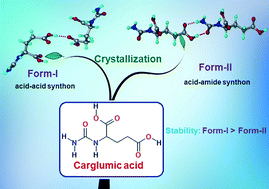Polymorphism in anti-hyperammonemic agent N-carbamoyl-l-glutamic acid†
Abstract
Carglumic acid (CGA) is used for the treatment of hyperammonaemia. The aim of this study was to investigate novel crystalline forms of CGA which can offer improved physicochemical properties and also to understand the stability relationships between such forms. We report two novel polymorphs I and II and a degradation derivative of the drug hydantoin-5-propionic acid (5-HPA). Crystallization conditions have been optimized to obtain each polymorph in reproducible crystallization batches. 5-HPA was obtained serendipitously upon crystallization of CGA in acidic medium (2-butanone : propionic acid). The X-ray crystal structures of CGA Form-I and Form-II and 5-HPA are sustained by carboxylic acid catemer and dimer, carboxamide catemer and dimer and an acid–amide heterosynthon. The two polymorphs are monotropically related. Thermodynamic stability, phase transformation, and Hirshfeld surface maps complement the structural analysis. Both forms are stable for two months under accelerated ICH conditions of 40 °C and 75% RH. Dynamic vapor sorption (DVS) showed that Form-I is more stable under moisture conditions than Form-II. Slurry crystallization, mechanical grinding and thermal measurements confirm the thermodynamic nature of CGA Form-I.

- This article is part of the themed collection: Polymorphism

 Please wait while we load your content...
Please wait while we load your content...